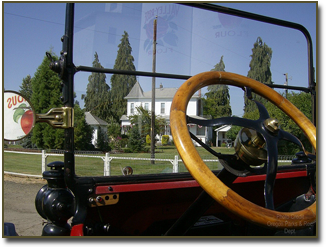Reflections

"More people need to be aware of the unique beauty of the mill so that they will help us overcome the challenges of preserving this structure."
—Tom Parsons, Park Ranger
Spring 2015 Page
Spring 2014 Page
2017 In Review
If you’re reading this you are part of a select group: people who know and care about Thompson’s Mills. While it is nice to be part of an intimate group, the future of the mill depends on our group becoming larger and louder. More people need to be aware of the unique beauty of the mill so that they will help us overcome the challenges of preserving this structure. The TMPS and OPRD have worked hard together on connecting more people with the mill, specifically by hosting hundreds and hundreds of local school students for our education programs and hosting cider pressing events. But you also can directly help connect more people with the mill by bringing friends here for a picnic, suggesting to visiting relatives that they stop by on their way out of town, or you could call or write influential people you know and tell them to come see this place for themselves (a visit on a balmy spring day would be best!). The mill’s future depends on Oregonians knowing about it. The more who know, the more will care, and the more voices will call for its preservation.
Meanwhile, 2017 saw some progress in preservation efforts, including some hands on actual care for the wooden building itself: I continued painting the west wall of the north warehouse and we prepped some nooks and crannies of the 3rd floor exterior for painting and likely gutter installation. Noted historic preservationist Fred Walters wrapped up his comprehensive preservation plan for the mill. We sprayed a low toxicity wood preservative on the floors, walls, and ceilings of the basement. We had an electrical engineer scan the building with a thermal camera for any hot spots in the mill wiring (found none) and we gave a training tour to the Halsey-Shedd fire crew volunteers. Mill friend and fire engineer Nick Artim found and hired a new alarm monitoring and service company, and we worked with state worker safety experts (SAIF) to make a plan for cleaning the remaining grain out of the bins upstairs. As mentioned earlier our education programs really took off, and we had an unprecedented number of adult special interest groups too. I moved and organized all the “stuff” that had accumulated in our bone-yard: heavy timbers, cinder blocks, bricks, pieces of metal roofing, old headgates, in preparation for moving the host sites behind the hay barn. We also had an extensive archaeology dig completed here to be sure that new utility trenches for the host sites would not harm any unknown underground treasures. Other projects that serve different kinds of needs were also completed this year: I assisted Tom Adams with his book Open the Flume Gates. If you’re reading the newsletter you should own a copy of this book. It is now a must-read for incoming hosts and volunteers. We planted 12 Oregon White Oak seedlings to expand the tiny oak savannah habitat at the north end of the property and while clearing some blackberry nearby, we found another 50 already growing! We interviewed Dorothy Prince, office manager in the 1970s, and learned that back in those days the mill was always well maintained and painted. Disco isn’t the only thing from the 70s I’d like to see come back!
In the coming year I hope we all continue to do our own part to preserve the mill. I will work tirelessly to protect this place, whether it is by direct preservation of the wood or by building programs or pursuing projects that will lead to long term care by OPRD. And you can share your interest and enthusiasm for this amazing place with our fellow citizens who have not been lucky enough to be exposed to it yet. Everyone who comes here, sees the towering silos, sees the hand hewn beams, feels the old grind stones and sees the turbines in action says the same two things: “This place is so cool!” and “I’ve lived in Oregon my whole life and never knew this was here!” Let’s hope that we can preserve the mill so it can give the same experience to more and more and more people.
Kind regards to all,
Ranger Tom Parsons
